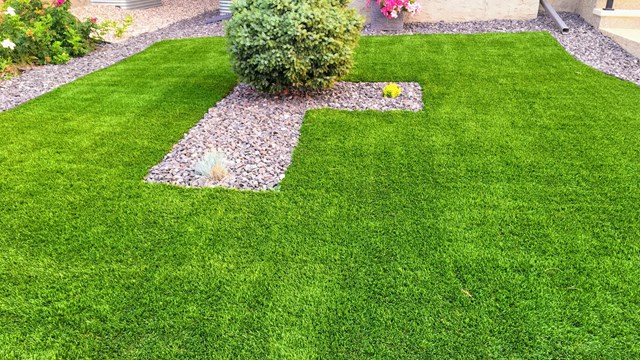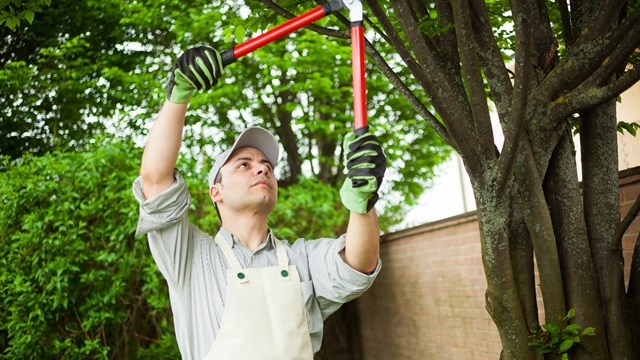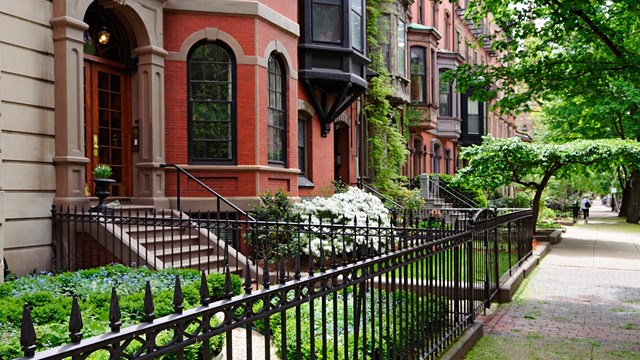An attractive, verdant lawn – or the lack of one – can make a lasting first impression on potential homebuyers. Grounds that are unkempt, weed-infested and showing more brown than green will likely lead visitors to believe that it’s not just the lawn that is suffering from neglect. And while cultivating a healthy lawn does involve some important steps, itneed not be an expensive and high-maintenance proposition.
“More doesn’t mean better,” says John Roberts, associate professor of plant biology at the University of New Hampshire, and this goes for all aspects of lawn care, including watering, fertilizing and mowing. “A good looking, healthylawn is simply a matter of following good cultural practices.”
Before one embarks on the quest for the perfect green space, first take a close look at the ground in question. It’s important to start at the lawn’s very foundation: whether just breaking ground, maintaining an existing lawn, or looking to liven up a struggling lawn. “Soil testing is a critical step,” says Bridget Ruemmele, a professor of Plant Sciences at the University of Rhode Island. Whatever you’re starting with, Ruemmele suggests having the soil tested at least once every two to three years (Test kits are available from yourlocal Master Gardener Program or Cooperative Extension office).
The results will determine what kind of fertilizer will best make up for your soil’s mineral deficiencies. The right pH, 6.5 to 7.0, can enhance the ability of grass to take up valuable fertilizer, tolerate drought conditions, and resist diseases, according to the University of Vermont.
Considerations such as the average daily amount of sunlight, type of soil, and how much foot traffic the area gets will determine what type of grass seed would be best suited for your lawn. Whether you’re starting with a brand-new lawn or boosting an existing lawn, choosing the right seed is essential. “If you start out with a good quality seed, you’ll have better results in the long run,” says Roberts. “You want to be sure there is the right variety of genetically superior seed for the kind of site you have.”
Three Grasses Prevalent
There are three types of grasses most commonly used (usually in a combination seeding) for most New England lawns. Kentucky bluegrass is favored for producing a lush, attractive lawn, providing there is plenty of sun and it has been well fertilized. While it is slow to establish, with patience and care Kentucky bluegrass spreads a system of underground rhizomes that continually produce new plants, explainsRuemmele, making for a long-lasting lawn with good winter hardiness. It withstands traffic fairly well, but will not tolerate overly-shaded conditions.
Several species of fine-leaf fescues are also used in combination with Kentucky bluegrass, providing grasses that flourish in shady areas. They are fairly low maintenance but do not fare well in high use areas. The third type of grass most often used in the mixed variety is perennial ryegrass, though in smaller quantities than the others. Perennial ryegrass is known for its quickgermination and good wear tolerance.
The amount of each type used in the seed variety will vary depending on site conditions. “Kentucky bluegrass is the most popular and attractive species for any usage,” says Ruemmele, “including most New England residential properties. When buildings are shading the turf at some point during the day, a mixture of Kentucky bluegrass and fine fescues would be preferred. In the shadier areas, the fine fescues will eventually dominate, while the Kentucky bluegrass will dominate sunnier areas after one or more years of establishment. For properties where the grass will not receive much foot traffic, fine fescues can be used in greater quantities, especially if you’re looking for a more low-maintenance turf.”
When deciding whether to start anew from seed or go with sod, it’s a matter of both cost and time. “Seeding allows a greater variety of mixtures from which to select,” says Ruemmele. “At least six weeks is required before acceptable turf is achieved. Even then, the longer traffic can be kept off new grass, the better. Sodding provides an immediate lawn (at greater expense), but it still requires a period of rooting, so traffic should be kept to a minimum for at least a few weeks.” Since most sodin New England is nearly 100 percent Kentucky bluegrass, it needs a site with ample sun; too much shade and all that expensive sod will fail.
Whether reseeding an older lawn or starting from scratch, Roberts advises using nature to your advantage. “Late summer to early fall is the time of recovery for grasses and the best time to start new seed or revitalize older lawns. The soil temperatures are warmerthan they are in spring, significantly decreasing seed germination time. Weeds and crabgrass are also petering out at this stage, creating less competition for good grass growth.” There’s also usually enough time for the new turf to establish enough protection for the oncoming winter, he adds.
Don’t Overdo Fertilizer
To keep lawns healthy, a fairly straightforward but regular system of maintenance should be implemented. Fertilization is one such regimen that is very beneficial, as long as it is not overdone. Don’t be fooled by what maylook like the perfect, emerald lawn, warns Ruemmele. “Unfortunately, what look like the most attractive, lush lawns are probably being over-fertilized and watered too frequently, setting them up for major pest problems in the future.”
Use only what you need, and avoid spring applications. Fertilizing a healthy lawn in spring increases top growth at the expense of root growth and makes it susceptible to insects and disease, according to the University of Vermont. Organic, slow release fertilizers can be used less frequently than others, usually at the rate of two applications per year. The amount of fertilizer and the rate at which it is applied depend on the type of grass on the site and its particular needs.
Older lawns in need of a boost will also benefit from a yearly (depending on levels of soil compaction) de-thatching, or aeration of the soil. “Thatch is an accumulation of decaying organic residues between the green portion of the grass plant and the soil. When it is more than 1/2" thick, it reduces nutrient and water absorption and harbors insectpests and disease-causing pathogens,” says the University of Massachusetts Extension website. De-thatching will remove old, dead tissue and make room for new growth; Ruemmele recommends doing this in the fall when growth is active and the grass can recover from the practice.
Irrigation is another vital process in maintaining healthy lawns, as long as it is used wisely. Unless you are starting with a newly-seeded area, there is little, if any, need to water the lawn in spring– and doing so may likely hinder healthy, natural turf growth. “Roots are lazy,” says Roberts. “They won’t grow deep if they don’t have to. It’s a common mistake to water more than needed and too early in the season, and this will promote shallow root growth.” Shallow-rooted grasses will not do so well in summer’s hotter, drier weather, when well-established plants will reach downward for stored water supplies.
Newly-seeded lawn, however, needs special attention when it comes to watering. “It is essential to keep the soil moist for the first 7-10 days until germination,” says Roberts.
“Irrigation, where it is desirable to keep turf green even in drought periods,” adds Ruemmele, “generally should not exceed one inch per week, including any rainfall in that amount. When it’s very hot, that amount could increase by a half-inch or more, though over-watering is something to be avoided. “Excessive irrigation promotes excessive turf growth, which is susceptible to disease and insect damage,” she cautions.
Even well-intentioned watering can pose a threat to your lawn. According to the University of Massachusetts Extension website, “too much water floods the air pores in the soil, depriving the roots of oxygen. Roots will then rot.” That’s how diseases find their way into the picture of your perfect lawn, turning that green to black. “Disease-causing fungi reproduce by spores that, like seeds, need water to germinate. Dry leaf blades reduce disease by reducing spore germination and infection by fungi,” the website states.
Don’t Under- or Over-Water
Knowing when and how to water is key to maintaining a healthy lawn, and especially in areas where water is expensive or there are restrictions on usage. Ruemmele recommends that the water be applied in one irrigation period rather than in light and frequent sprinklings, meaning the turf should not require watering more than once per week. It’s best to water early in the day, so the turf will dry quickly; evening watering promotes some diseases, especially brown patch and Pythium blight, says Roberts. Water applied in the heat of the day will be lost to evaporation and do little to nourish the lawn.
Roberts also advises not to start a watering schedule (on an established lawn) until signs of water stress are evident. Just like other plants, grasses go through periods of dormancy. This is especially so in the heat of the summer, when growth is at a minimum. A lawn that has dulled a bit toward brown isn’t necessarily dead, explains Roberts. Peel back the blades toward the soil surface: if you see green, the grass is still very much alive; growth and greening will resumewhen temperatures drop and rainfall amounts increase. A little browning is simply the plant’s natural defense mechanism.
Many association properties are already equipped with sprinkler systems for lawn maintenance, and this can be used to great advantage when looking to keep the lawn healthy without a lotof water waste. “Automatic controllers are now available that are equipped with rain sensors to take rainfall into account and reduce the irrigation timing to the desired level,” says Ruemmele. While these sensors may seem costly, their long range benefits – a healthier lawn and reduced water usage – soon outweigh the initial expense.
Mowing is another part of the regular maintenance equation. “Grass should be mown as often as needed so that no more than 1/3 of the leaves are removed in a single mowing,” says Ruemmele. “During the most active parts of the growing season (spring and fall), this may mean mowing twice a week. During the hotter parts of the summer, when the temperature is less ideal for grass growth, mowing may be once a week or less.” Be sure not to cut grass too short; doing so will lead to excessive browning and may kill the grass during stress times.
Clippings can be left where they fall if they are less than one inch in length. This will reduce the amount of fertilizer needed by 25%, because turfgrass clippings contain nutrients that are released back to the soil, recommends the University of Vermont. Be sure to keep mower blades sharp; dull blades fray grass tips, giving the lawn a whitish-brown appearance.
Pesticides need only be used as a last resort. “A truly healthy lawn won’t need pesticides,” says Roberts, “because good cultural practices will eliminate the need for them.” Dense, lush turf leaves little room for weeds, and a lawn not weakened by diseases will have plenty of natural defenses against insect predators.
That’s the key: the more you do to create a naturally healthy lawn, the lesstime, effort and expense it will need for the long run.
Laura Scheel is a freelance writer and a frequent contributor to New England Condominium magazine.






Leave a Comment